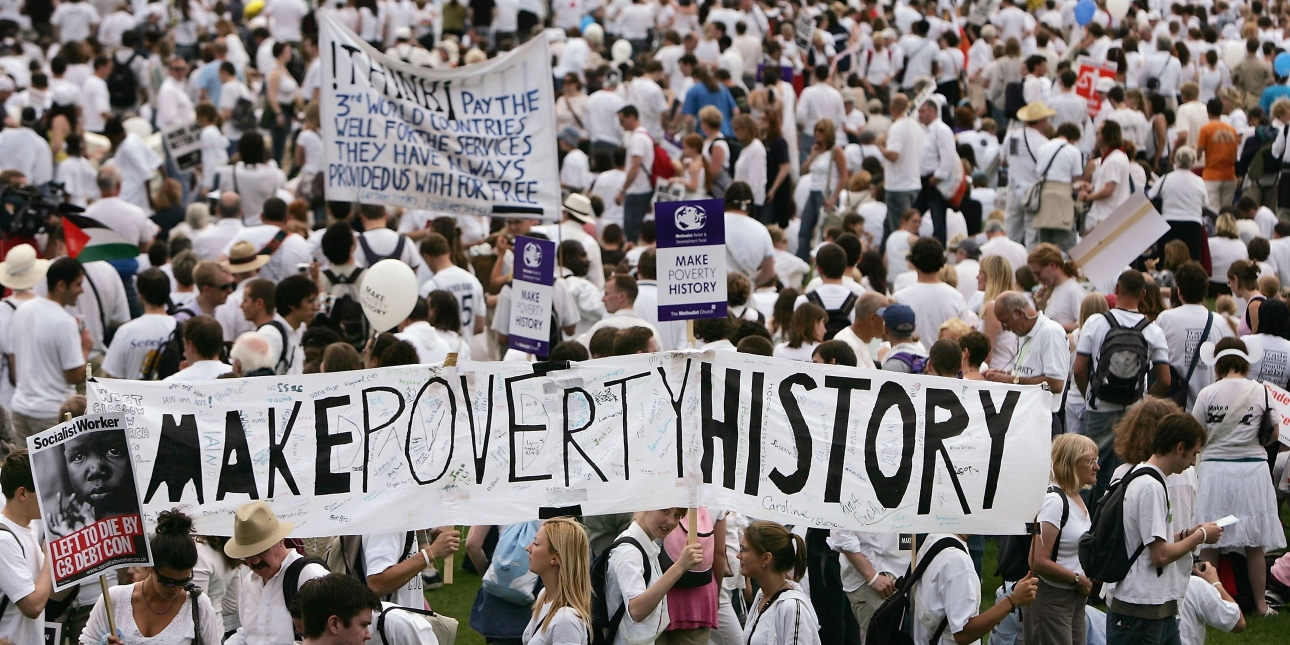Anatomy of a PR campaign: Make Poverty History
Launched 20 years ago this month, Make Poverty History united millions, and secured aid pledges from Blair, Bush – even Putin. Here’s the story of the first big charity campaign of the digital era
For Chris Martin of Coldplay, it was “the greatest thing that’s ever been organised probably in the history of the world”. For Bill Gates, it had the potential to become “the best thing that humanity has ever done”. While no less than Nelson Mandela suggested it could have the power to eradicate poverty in a similar way to the struggles against slavery and apartheid.
Consequential words. Then again, Make Poverty History really did achieve some remarkable things – especially when it came to PR. Within just six months, the coalition of over 500 charities/NGOs had organised the Live 8 concerts (watched by three billion people) and mobilised 225,000 to form a ‘human chain’ in Edinburgh. In the UK, over seven million of us wore the ubiquitous Make Poverty History white wristbands – as much a 2005 fashion statement as trucker hats and a pair of skinny jeans.
Public awareness, meanwhile, was off-the-charts: within half-a-year of launching, its brand recognition in the UK jumped from zero to 88%, a figure higher than Coca-Cola. From Mandela to Madonna, Mariah, and Pope Benedict, there were few public figures who didn’t get involved.
More importantly, Make Poverty History accomplished its aims to get the G8 to cancel debt for some of the world’s poorest countries – and pledge billions of extra dollars in aid. It’s even more extraordinary, given the international leaders who agreed to help dispel global poverty during the 2005 Gleneagles G8 summit were a motley bunch of strongmen, including Vladimir Putin, Silvio Berlusconi and George W Bush.
It was a different, more innocent era, true. But Make Poverty History caught a PR sweet spot. It was one of the internet’s first mass charity campaigns, but happened two years before smartphones, social media and the Great Recession changed comms forever.
“The big learning for me is that both PR and campaigning are collaborative,” says Glen Tarman, a Make Poverty History co-founder who oversaw the movement’s digital comms. “If you want to give your campaign the best chance of succeeding, it doesn’t just mean grabbing people's attention, but also creating conditions in which people will respond. When people see they’re part of something bigger, they want to get involved.”
Indeed, Make Poverty History was an open-source, ‘bottom-up’ campaign which encouraged public participation, whether churches wrapping spires in white bands, or people lobbying their MPs about anti-poverty via email.
A unique campaign
Writing to a politician was how Make Poverty History started in late-2003, with a letter from a cabal of aid agencies to Tony Blair. With the UK’s presidency of both the G8 and EU coming up in 2005, the charities beseeched the then-PM to use the tenure as an opportunity to cajole other leaders into dropping the debts owed by developing countries.
“The initial reply [from Blair] was pretty limp,” remembers Tarman. “If anything, it galvanised us to create a serious campaign different to anything done before.”
In the early noughties, both Jubilee 2000 and Drop the Debt proved that mass movements could help publicise the issue of debt cancellation for developing countries. But Make Poverty History was bigger: a coalition of over 500 charities/NGOs such as Oxfam, Christian Aid, Save the Children and Tearfund all collaborating on the campaign. The PR/comms was conducted by a collection of ‘working groups’ (including press, comms and a new media group headed by Tarman); teams working on Make Poverty History as part of their day jobs.
It wasn’t just the working methods that were different: who Make Poverty History wanted to target also broke with the past. “We wanted it to have a popular feel so politicians couldn’t ignore us,” recalls Tarman.
Throughout 2004, Make Poverty History (its name was coined by copywriter Mary Wear) thrummed along, building support among grassroots activists. Love Actually/Four Weddings screenwriter Richard Curtis also became involved. His input was invaluable: not only was Curtis vice-chair of Comic Relief, but he provided Make Poverty History’s first critical piece of PR. On the evening of the campaign’s launch on New Year’s Day 2005, that evening’s The Vicar of Dibley featured Dawn French’s titular minister persuading her friends to don white wristbands and support Make Poverty History.
Curtis also reached out to ad agency Abbott Mead Vickers, who created the campaign’s two big visual signifiers: the white wristbands and chilling “click” TV adverts which showed celebrities such as Brad Pitt, George Clooney and Kate Moss clicking their fingers every three seconds – the rate at which a child dies from extreme poverty.
“I wrote a brief talking about how all the big protest movements used a single colour, action, or hand gesture,” says Tarman. “But we didn’t know these silicone white wristbands would become fashionable, or that people in the street would wear them. They took off to the surprise of everybody.” It wasn’t long before seven million Britons were wearing them.
The press also embraced the campaign, dedicating front pages to the cause or despatching journalists to Africa. There was also an auction for the advertising industry where Curtis and Bob Geldof persuaded ad teams to give away free space for the campaign.
One big problem
Despite the positive coverage, Make Poverty History’s comms teams had one big problem. Unlike the Band Aid/Live Aid fundraisers two decades previously, this wasn’t about everybody from grannies to kids donating spare pennies/pocket money but pressuring politicians instead. To hammer home the non-donation message, Make Poverty History even created a (sadly unused) advert, paraphrasing Bob Geldof’s famous missive, emblazoned with the words ‘Don’t Give Us Your F****** Money’.
“In PR terms, it was tricky,” says Tarman. “Back then, the public didn’t have a great deal of knowledge about the unfairness of global trade. The comms was a balancing act, trying to shift the focus to justice [rather than donations]. Yet, the more popular we became, the more the message simplified. The British public responded in ways we never anticipated.”
Key to mobilising public support was the movement’s use of the internet. Although commonplace now, the campaign’s use of email lists in 2005 was novel, with Make Poverty History’s directory of 500,000 contacts embracing the frictionless way of interacting with the charity and MPs. “At that time, sending out a call-to-action by pressing a button which could reach 500,000 people was very new,” says Tarman. “It resulted in amazing open/action rates.”
Make Poverty History’s shrewd use of digital also enabled the campaign to reach a young audience: when polled by Oxfam the following year, 84% of 16-25-year-olds said the campaign and Live 8 concerts had the biggest impact on them during 2005. “It was important for us to target young audiences,” says Tarman. “And this was the first generation who was digitally native. It offered them a chance for their voices to be heard.”
Nelson Mandela also tapped into this youthful idealism when speaking at a Make Poverty History Trafalgar Square rally in February 2005, telling the packed crowd: “Sometimes, it falls upon a generation to be great. You can be that great generation.”
Finding solutions
Events snowballed: Dawn French led a march of female clergy to No 10 Downing Street, trade injustice was a key motif of March’s Comic Relief, while 25,000 people filled Whitehall for an all-night vigil in April.
At the same time, the comms campaign faced challenges. “The cause was sometimes viewed as being ‘political’ with issues that could be seen as ‘challenging’ to the government, which it was meant to be” remembers Tarman. It also resulted in the “click” ads being banned on television and radio by media regulator Ofcom for being “towards a political end”.
With the groundswell mounting until July’s G8 summit, Bob Geldof stepped in. The musician/campaigner had long-resisted calls to host a second Live Aid. However, in late-May he announced Live 8: a concert extravaganza with 11 free shows in nine countries featuring mega-wattage acts such as Madonna, Stevie Wonder, Paul McCartney and U2.
In 1985 questions were raised about the lack of Black and African acts on the Live Aid bill. Live 8 was no different. The original line-up for the London Hyde Park concert only featured one non-white artist (Mariah Carey), although a Live 8 concert in Johannesburg and an ‘Africa Calling’ concert (featuring an all-African line-up) in Cornwall were subsequently organised. (The notion that the aid movements help craft a narrative about Africa being a helpless continent that needs ‘saving’ was recently reignited with Ed Sheeran’s/Fuse ODG’s criticism of Band Aid’s 40th anniversary single.)
Nonetheless, the Live 8 concerts were a huge success; one particularly poignant moment came when Birhan Woldu – a starving child in the 1980s’ Ethiopian famine who appeared in video footage shown at Live Aid – was brought on stage in Hyde Park for the world to see the healthy young woman she had become. The same day, 225,000 activists in white clothing formed a ‘human chain’ around Edinburgh city centre to show solidarity with the world’s poorest people. And with London awarded the 2012 Olympics a few days later, a joie de vivre promising a more hopeful future gripped the UK.
An indelible imprint
The feel-good factor evaporated the next morning with the news from London that three bombs had exploded during rush hour on the Underground. It was the UK’s worst terrorist atrocity; understandably Make Poverty History no longer dominated headlines. “The 7/7 bombings affected the campaign a lot,” says Tarman. “Obviously, we were mindful of the suffering [in London] but we assumed everything we’d done was possibly about to be in vain.”
Yet arguably the tragedy emboldened Make Poverty History’s cause by giving leaders the opportunity to provide a defiant riposte to terrorism. On 8 July at Gleneagles, the G8 leaders announced they would double aid to Africa (an extra $48bn a year by 2010) and write-off debts for more than 30 countries. The eight countries also agreed to contribute 0.7% of their gross national income to overseas aid. “It was a significant amount of debt relief,’ says Tarman. “There were some great deals about access to Aids treatments too.”
With many charities leaving the coalition after the G8 summit, Make Poverty History soon vanquished from the public eye. “We couldn’t recover the momentum after that; it was a challenge [to maintain the impetus],” says Tarman. “Also, the PR focus shifted onto the work being done around international trade: a more complicated issue to convey to people than aid or debt cancellation.”
Still, 20 years on, Make Poverty History has left an indelible imprint. Tarman notes it helped raise the profiles of many of the coalition’s charities. Many current politicians started their careers in the movement, whether it’s Scottish MP Kirsty McNeill (a Make Poverty History board member) or Labour MP David Taylor, a former Make Poverty History activist who still wears the wristband and mentioned the campaign in his maiden House of Commons speech. It’s also possible to detect vestiges of Make Poverty History’s grassroots activism in the Occupy movement, the climate protests, and even Black Lives Matter.
“Sometimes PR can work for the world’s worst interests but Make Poverty History demonstrated PR can be deployed for good in ways the public will respond to,” says Tarman. “It really was incredible; we were blown away by how many people embraced this.”
Find out more
Discover the legacy of Make Poverty History on the Comic Relief website.
 Christian Koch is an award-winning journalist, editor, content strategist and brand consultant.
Christian Koch is an award-winning journalist, editor, content strategist and brand consultant.


